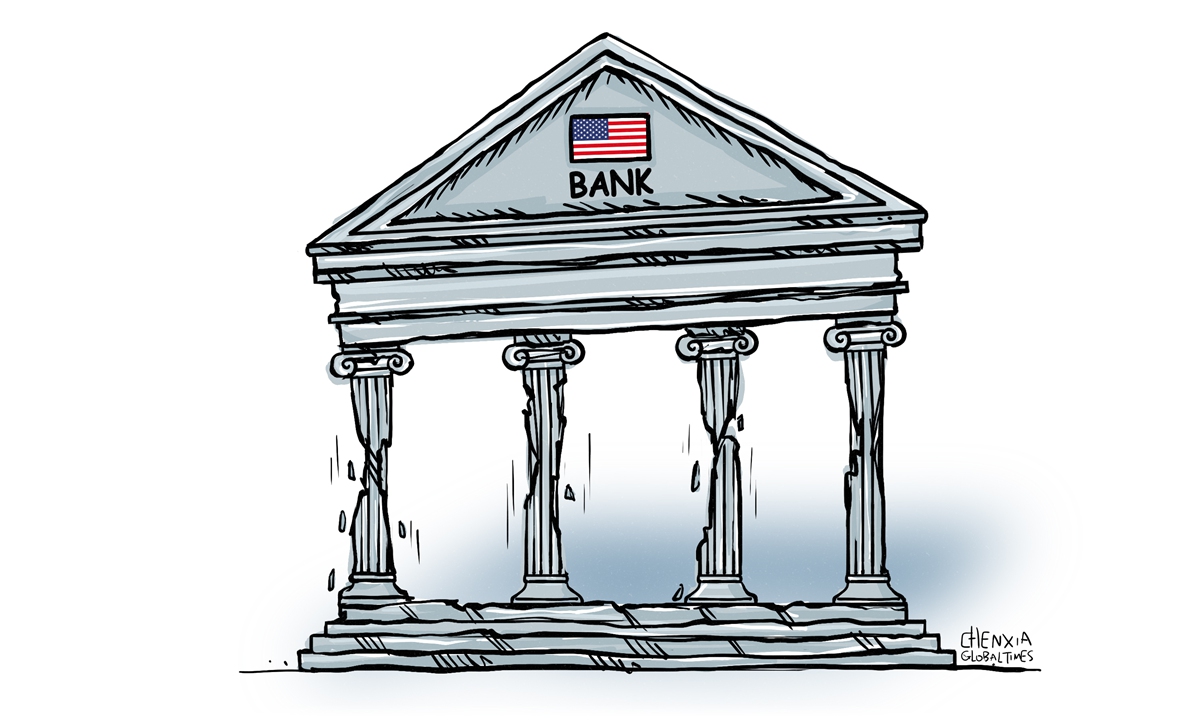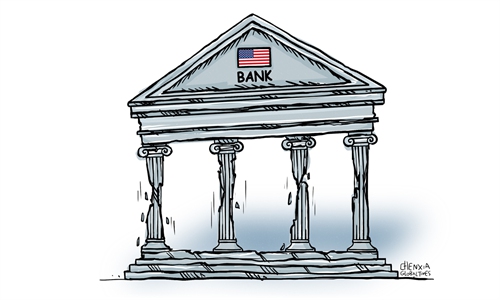
Illustration: Chen Xia/Global Times
Less than three months after the most recent US bank failure, a lender in the state of Kansas was closed by local regulators. Given the Federal Reserve's aggressive interest rate hikes, the closure may not be the last one, experts said on Monday.
Kansas regulators on Friday shut down the Heartland Tri-State Bank due to insolvency and appointed the Federal Deposit Insurance Corp (FDIC) as a receiver, according to a statement released by the FDIC.
With only four branches, Heartland was the smallest of the five US banks that have collapsed this year. However, even the small bank failure could unnerve the market. A report by Yahoo Finance said that the bank closure means "the banking turmoil of 2023 has arrived in small-town America."
As of March 31, Heartland had about $139 million in assets and $130 million in deposits, the FDIC revealed.
Other lenders that have failed so far this year, excluding the voluntary liquidation of SVB, had total assets exceeding $100 billion.
Among them, First Republic Bank, with about $229 billion in total assets at the time of takeover in May, became the second-largest bank to fail in US history.
While regulators deemed the Heartland failure to be an isolated case, the stream of bank failures has highlighted the negative impact of the Fed's monetary tightening on the banking system, a Chinese expert said.
The Fed's aggressive interest rate hikes since March 2022 have led to cash crunch woes for the banks, Gao Lingyun, an expert at the Chinese Academy of Social Sciences in Beijing, told the Global Times on Monday.
For example, SVB collapsed amid a bank run, which was triggered after it sold its US Treasury bond portfolio at a large loss, causing depositor concerns about the bank's liquidity. The bonds had lost significant value as market interest rates rose after SVB bank shifted its portfolio to longer-maturity securities.
So far, regulators in the US have been quick to respond, learning the lessons of the 2008 financial crisis. However, it still cannot be ruled out that more banks may face similar financial problems, Gao said.
The US has better ways to tame inflation than relying on interest rate hikes. For instance, removing the punitive high tariffs on Chinese goods would greatly contribute to curbing inflation in the US, Gao noted.
Due to the special status of the US dollar in the global economy, US monetary policy has a significant impact on global financial stability. The fallout in the US would spill over to other countries, so Washington needs to communicate with other major nations when formulating macroeconomic policies, Gao said.
In the Global Financial Stability Report 2023 released in April, the IMF pointed out that the turmoil in the US banking sector has increased the risks to global financial stability.
"Recent turmoil in the banking sector is a powerful reminder of the challenges posed by the interaction between tighter monetary policy and financial conditions and the buildup in vulnerabilities since the global financial crisis," read the report.
"As a major power, the US should bear the corresponding responsibility that comes with its policy choice," Gao said.

